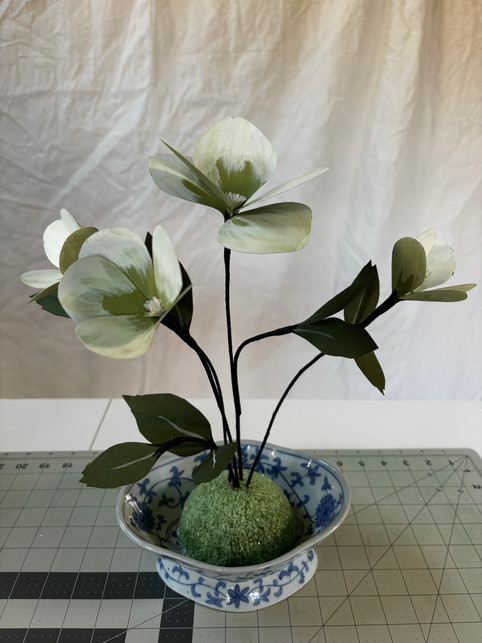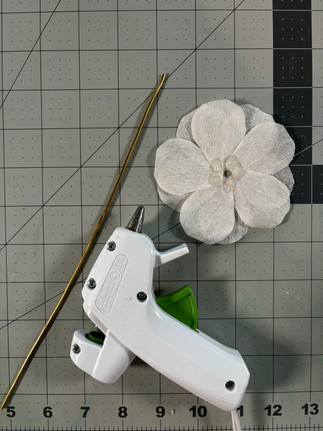handmade paper flowers
- Marsden Brown
- Apr 3, 2024
- 6 min read
Updated: Apr 23, 2024
Repurpose dishware and paper scraps and into bespoke blooms

Materials:
Paper scraps, including
cardstock
craft paper
crepe paper (we used a leftover roll of crepe paper ribbons!)
whatever other paper scraps you have on hand!
Paints & paintbrush - watercolors or craft paint work well here
Styrofoam or craft/floral foam (we suggest saving saving packing foam from packages you receive in the mail!)
Containers like bowls, pitchers, or pots (as always, we encourage using what you already have around the house or sourcing from thrift stores)
Wire - we mostly used floral wire here but any sturdy but pliable wire would work well
Floral tape
Hot glue gun
Elmer's glue
Wire cutters/sharp scissors
Moss - either from the great outdoors or a craft store if you live someplace without easy access to moss
Spray bottle
Rubbing alcohol or vodka (just a splash)
Getting started:
This tutorial will outline the process for making 3 different kinds of flowers - hellebores, begonias, and cyclamen - but the sky's the limit when considering which kinds of flowers or other plants you'd like to create!
Hellebore:
Making the petals:
First, decide how many blooms you would like to have on your plant and how many petals per bloom, then calculate the total number of petals and leaves you will need to cut out.
We aimed for around 3 blooms per plant, with a mix of some larger and some smaller blooms. Larger blooms had 5 petals and smaller blooms had 3 - we weren't aiming for horticultural accuracy, just aesthetic preference!
We found that we needed at least 10-15 leaves for a nice amount of greenery
Cut out several large petals, small petals, and leaves of a range of sizes from the your paper scraps. Feel free to use the shapes below as a rough guide:

If needed, paint the entirety of each petal and leaf your desired base color (you can start with white paper and paint whatever color you'd like, or if you're working with colored paper, you can leave it as is)
Paint several brush strokes outward from the center of each petal or inward from the outer edge of the petals, depending on your desired look. Our smaller blooms show the inner brush strokes and our larger blooms have brushstrokes from the outer edge.
be sure to paint both sides, since both will be visible!
Paint a thin brushstroke out from the center of each leaf
Lay all pieces out to dry
Assembling the blooms:
Determine the desired length of your stems and cut your wires accordingly, adding at least an extra 2" to insert into the foam base
we made a mix of shorter stems and longer stems - around 4 shorter stems and 3 longer stems per plant
Lay a strip of crepe ribbon, tissue paper, or other thin white paper under the end of the wire, leaving a couple centimeters of the paper overhanging the edge of the wire; then roll the paper, securing with hot glue as you go
Using sharp scissors, cut extremely thin strips around the end of the paper roll, then gently fan out the strips with your fingers. This forms the anthers of the flower and also conceals the end of the wire
Using hot glue, attach the base of each petal just below the paper "anthers," gently bending the paper to flare out the petals
Finishing the stems
Once the flower is complete, wrap the stems with floral tap, beginning at the base of the petals, using a dab of hot glue to secure the tape at each end
Add several brushstrokes matching the floral tape upwards along the petals and leaves to blend the edge of the tape
Repeat as desired for additional blooms and leaves, using the floral tape to add additional stems and leaves partway down the main stem

Arranging the stems:
Measure your container and cut your foam accordingly
Hot glue the foam to the interior of the container
Poke holes in the foam where you would like your wire stems to go, add a dollop of hot glue, and insert each stem. Hold until the glue has cooled some
The finishing touches:
Bend the wires to adjust the stems as desired
Use hot glue to adhere clumps of moss to the top of the foam, covering the surface entirely
Make a solution of 1 part Elmer's glue to 4 parts water, plus a splash of rubbing alcohol, in your spray bottle
Shake well and saturate the surface of the moss with the glue solution to help set the moss
Wipe any excess glue spray from the edges of the container, and voila!

Crepe Paper Begonia:
Making the flowers:
Determine how many flowers you would like to have and calculate how many petals you will need - we made two clusters with 4-5 flowers each, with 10ish petals per flower, so we needed around 45 petals
Fold crepe ribbon over itself repeatedly, making an accordion about 1.5" wide (you can make this as thick as your scissors can cut through)
Cut a petal shape into the layers of crepe to make multiple petals at once
Use small dots of Elmer's glue to assemble rounds of petals, using 5-6 petals per round. Leave a small hole at the center of each round
Lay 2-3 rounds on top of each other, staggering the petals so they don't overlap perfectly, using Elmer's glue to adhere
Cut your wire - we made one long central stem and 3-4 shorter stems to attach to this main stem for the flowers
Insert the wire through the center hole, scrunching the petals forward around the edge of the wire, and secure using hot glue
Wrap the stem with floral tape, securing the ends with hot glue
Repeat until you have at least 5-6 flowers, using floral tape to attach the additional flowers the central stem to make a cluster
If desired, paint the floral tape the shade you would like your stems to be - we used white floral tape so that we could customize the shade of green of the stems
Making the leaves:
Determine how many leaves you would like, then cut in a range of sizes out of scrap paper using the shape below as a guide:

Paint a border around edges of the leaves, as shown below
Cut your desired lengths of wire - we kept our leaves shorter than the flowers but varied the height of each slightly
Wrap the wires in floral tape
Hot glue the wire to the underside of each leaf
Use a little paint or decorative tape to cover the hot glue once dry
Assembling your begonia:
Measure your container and cut your foam accordingly
Hot glue the foam to the interior of the container
Poke holes in the foam where you would like your wire stems to go, add a dollop of hot glue, and insert each stem. Hold until the glue has cooled some
Repeat the finishing touches outlined above for the hellebores: adjust the wires as desired, adhere your moss, spray the glue solution, and you're done!

Cyclamen:
Making the flowers:
Determine how many flowers and leaves you would like, and cut out the appropriate number from your scrap paper using the shapes below as a guide

Paint several brushstrokes from the edge of each petal towards the center
Paint a decorative border 1-2 centimeters from the edge of each leaf
Assembling the stems:
Measure and cut the wire your desired lengths, making the wire for the flowers longer than the ones for the leaves, plus at least 2" to insert into the foam
Wrap the wire in floral tape, using hot glue to secure the ends
Fold the flower petals into threes as shown below, and use hot glue to adhere the inside of the folded flowers to the tip of the longer wires
Hot glue the ends of the shorter wires to the underside of the leaves
Use a little paint or decorative tape to cover the hot glue
Putting it all together:
Measure your container and cut your foam accordingly
Hot glue the foam to the interior of the container
Poke holes in the foam where you would like your wire stems to go, add a dollop of hot glue, and insert each stem. Hold until the glue has cooled some

Follow the aforementioned finishing touches to attach and set the decorative moss
Shop the Craft and Support our Mission!
Our Note: Cut flowers have a hugely detrimental environmental impact (source). the majority of the cut flowers sold in the U.S. are imported from Colombia and Ecuador, with others coming from as far away as Kenya and Sri Lanka. In addition to being high water-use crops, fresh cut flowers require refrigeration, air transport, and long-haul truck transport in order to arrive at their final destination - all of which carries an enormous carbon footprint. Furthermore, most flower farms use toxic fertilizers and other chemicals that are hazardous to the health of the farm workers as well as damaging to the local ecosystem.
Enter this craft: it would make a great gift in lieu of cut flowers, and it'll last longer! It's also a great way to use up paper scraps and keep chunks of styrofoam out of landfills. A win-win-win :)

















































Comments